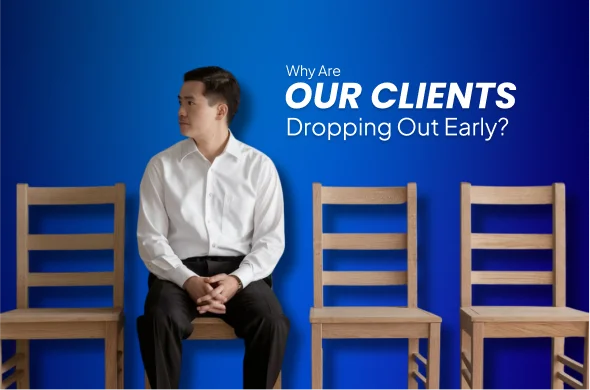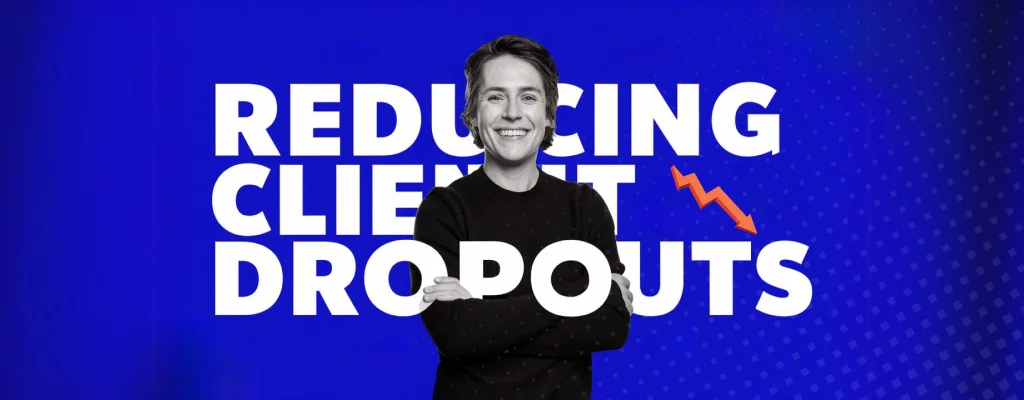
For this article, patients are referred to as clients.
While continued medical care remains ideal, it doesn’t always show tangible results. Thus, clients turn to early self-discharge. Especially when things get “wonky,” it’s easier for them to drop out.
This scenario captures how client retention has become a pressing concern for allied health practitioners (AHP). In this article, we’ll explore why our clients drop out early and what AHP can do about this.

Client dropouts don’t just happen abruptly. Regardless of whether knowingly or unknowingly, they show various signs that they are about to drop out, including:
When clients start canceling or not showing up to scheduled appointments, it indicates that they are no longer interested in continuing their treatment.
When clients show disappointment that their treatment is taking longer than expected, they will likely drop out and seek alternatives. On the other hand, rapid progress and improvement may also cause them to think they no longer need the treatment, thus discontinuing it.
Less unfortunate clients facing financial dilemmas and insurance ineligibility are more likely to fail to complete their treatment. Thus, it's important to break financial barriers to help encourage clients that the price of treatments matches their actual value.

Recognizing the red flags of client dropout gets only half the job done; acknowledging why it is a problem can help you find potential solutions.
So, what is the problem with early client dropouts?
When clients drop treatment early, they may be unable to rehabilitate fully. This inability can require clients to return for treatment if the problem or injury returns at a later stage (a flare-up).
A return to the treatment process will ultimately incur greater treatment costs as opposed to rehabilitating the condition fully with the first incidence.
Recurrence of a condition or injury may result in greater frustration levels and potentially heightened anxiety levels, taking a toll on the client’s mental and physical health.
A returning injury can reduce the clients’ physical function, affecting their overall health and physical fitness.

Treatment dropout rates have been reported as high as 50-60%. In Australia, the average retention rate for physiotherapy patients is three visits across Healthia. The normal attrition rate is around 10 to 30 percent, while 70 percent of that group leaves because they do not feel valued as patients.
From internal to external factors, here are some common reasons why clients drop out early:
Ineffective and lack of communication between the provider and the client may affect the latter’s perception. Clients often depart because the perceived value of continuing care is not adequately conveyed.
Meanwhile, although client expectations may have been met, the benefits of ongoing treatment must be clearly defined to avoid abrupt treatment cancellation. It’s imperative to demonstrate the merits of continued care because health improvement may change the client’s priorities, not to mention there are other factors that may force them to drop out, such as financial constraints, relocation, and career changes.
When clients grapple with scheduling appointments due to logistic challenges such as traffic, poor work-life balance, and transportation, they may be unmotivated to continue treatment. Besides this, clients may be persuaded to turn to online solutions that are prevalent on the internet.
More so, client’s trust to the AHP may be compromised when they are scheduled on a visit-to-visit basis rather than following a clinically justified treatment plan. Providing care session by session may raise suspicions on whether the practitioner’s recommendations are driven by self-interest or the client’s well-being.
While several reasons may drive clients to drop out of medical treatments, it may also be caused by the practitioner’s lapses, including:
Clients may also have unmanageable expectations which can lead them to discontinue treatment. They may anticipate faster progress than what the treatment and their body can achieve, leading them to become unappreciative and even impolite.
On the other hand, clients may be too delighted when they see an inch of progress. This may lead them to drop out of the treatment, resulting in incomplete rehabilitation.
Clients may also be ashamed that they don’t care about their health as much as the practitioners do. Or maybe, they feel awkward telling the practitioners when was the last time they visited a clinic. These instances may lead them to reject treatment.
Thus, it is important for AHPs to elaborate on the rewards of continued care. For instance, if a patient is not convinced their home exercise program is effective, they are more likely to stop doing it.
Other external factors affecting early client dropout include:

Here are three strategies for how AHP can enhance client retention:
Ensure that patients understand how completing their treatment directly contributes to reaching their rehabilitation objectives. By linking exercise completion with progress towards their goals, patients are more likely to remain motivated and committed.
Encourage patients to monitor their own progress but simplify the process and maintain accountability. Provide easy-to-use tools or apps for tracking exercises and progress, and regularly review their logs during appointments to hold them accountable and offer guidance as needed.
Opt for a Home Exercise Program platform equipped with features designed to enhance patient engagement. Look for platforms that offer interactive exercises, progress tracking, reminders, and educational resources tailored to each patient's needs. Choosing the right platform can significantly increase patient adherence and overall success with their exercise regimen.

Patients may discontinue treatment if they perceive that their needs are not adequately addressed. Therefore, it's essential to create a positive patient experience, through the following:
Implement regular communication channels such as phone calls, text messages, or emails to remind patients of appointments and send satisfaction surveys. Additionally, provide promotional materials like brochures or fact sheets to build rapport and strengthen long-term relationships with patients.
Clearly communicate the treatment process, duration, and necessary requirements for achieving successful clinical outcomes. Managing patient expectations helps in fostering trust and ensuring patients are well-informed throughout their treatment journey.
Provide training to all staff members on effective medical customer service techniques, emphasizing a patient-centred approach. Empowering staff to communicate effectively with patients helps them feel heard, understood, and valued.
Optimize the check-in process by updating facilities, providing staff training, and utilizing virtual receptionist software solutions like Welcome Ware. Reducing wait times demonstrates respect for patients' time and contributes to a more positive overall experience.

In today’s fast-paced world, convenience is a top priority. Most clients have busy lives, thus they seek care that is easy to initiate, navigate, and access. To achieve this feat, modernizing client experience is crucial.
Simplifying the process of getting started at your clinic is the first step to streamline client experience. This ensures the delivery of high-quality care and showcases your commitment to putting clients first.
But how can the AHP do it?
Prioritize creating a seamless care journey for clients by refining the onboarding experience. Simplify administrative processes and ensure clarity at every step to minimize confusion and frustration.
Enhance access to top-tier care for clients with busy schedules, residing in remote areas, or facing transportation challenges. Implement telehealth services or mobile clinics to reach clients wherever they are, ensuring no one is left without access to essential care.
Utilize technology to automate communication and appointment reminders, fostering client engagement and compliance. Implement systems for sending timely messages via text, email, or app notifications, keeping clients informed and involved in their care journey effortlessly.

Delivering client care with a blend of clinical expertise and empathy makes the perfect formula to reduce client dropout. By combining clinical skill with compassionate understanding and proactive improvement measures, you can ensure that clients feel supported and motivated to complete their care plans successfully.
Here’s a simple guide in fostering client trust and alliance:
Ensure your providers exhibit mastery and confidence in their clinical abilities. Invest in continuous training and professional development to uphold a high standard of care, instilling trust, and confidence in your clients.
Equip your providers with strong communication skills to establish rapport with clients. Training in active listening, empathy, and clear articulation fosters meaningful connections, enhancing the overall client experience and satisfaction.
Proactively identify areas for improvement within your practice, whether it's in service delivery, facilities, or communication channels. Take actionable steps to address issues and enhance the client experience continuously.
Cultivate a culture where satisfied clients are encouraged to promote your practice through word-of-mouth referrals and positive reviews. Utilize testimonials and feedback to showcase the quality of care provided, further bolstering your practice's reputation, and attracting new clients.

Meeting clients where they are fosters a sense of support, motivation, and engagement. As an allied health professional (AHP), it's crucial to accurately assess and respond to each client's unique needs.
By understanding individual requirements, you can tailor your approach to strengthen engagement effectively. Leveraging the right digital tools can further enhance this process, providing additional support and resources to clients wherever they are in their journey.
To enhance patient engagement and care, it’s vital to carry out the following:
Guide clients through their journey by providing ongoing education to enhance autonomy, independence, and achieve optimal clinical outcomes. Equipping them with knowledge empowers them to take a more active role in their health.
Evaluate each client's level of engagement and tailor support to empower them, building the confidence needed for active participation in their health journey.
Utilize technology to support, reinforce, and deepen client engagement. Implement digital tools and platforms that facilitate communication, tracking progress, and accessing resources conveniently.
Train staff in client-centred care principles to establish a therapeutic alliance and foster trust from the outset. Focus on understanding and addressing the individual needs and preferences of each client.

A common misconception among clients who self-discharge from treatment is the belief that the absence of pain signifies complete rehabilitation. However, this perception overlooks the crucial fact that unresolved injury factors during rehabilitation can lead to potential flare-ups. Therefore, relying solely on pain absence as an indicator of full rehabilitation is misleading and can pose risks to the individual's long-term recovery.
This is where My Allied Health Academy (MAHA) comes into play.
MAHA offers online training and support for AHPs. It designs ideal practices, frame practice models, build brands, and monitor progress. It enlightens practitioners on how to attract more of the right clients, helping reduce early client dropouts.
Additionally, MAHA allows AHPs to navigate the intricacies of client dropout. When clients are dropping out, knowing where to focus is critical to what happens next. MAHA helps practitioners come up with a clear and reasonable treatment plan, one where the client is more likely to comply with.
MAHA can help you avoid the pitfall of losing clients by teaching the practitioner the fundamentals. It shows the AHP how to create teachable moments with their clients and encourage them to show up more often.
MAHA takes you one step closer to effective allied health marketing.
To learn more visit www.myalliedhealthacademy.com or sign up.
